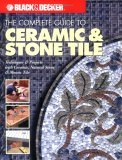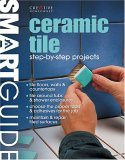Tiling over Concrete and Wood Subfloors
By Mark J. Donovan
|
|
Tile Subfloor preparation is critical for a quality ceramic tile installation job. In general, tile Subfloor preparation includes insuring a stable and level subfloor that is free from dirt, dust and any type of chemicals that could prevent proper bonding between the ceramic tile and the concrete or wood subfloor.
Tiling over Concrete Subfloor In general a cement or concrete subfloor is the best surface for installing ceramic tile. However, the concrete floor needs to be flat and level and free from any type of chemicals that could prevent a proper bonding between the ceramic tile and the concrete surface. |
If there are any paints or sealers on the concrete it needs to be removed. There are floor strippers, floor scrapers and abrasive scouring agents that you can purchase from any home improvement store to help aid in this process.
Also, if the concrete floor is new, the installation of ceramic tile should be delayed for 1 month to allow full curing of the concrete. The moisture levels in concrete must be low (below 16%) for proper bonding of tile. If chemicals were used in the curing process of the concrete then the concrete may be unsuitable for directly applying ceramic tiles.
| If the concrete floor is not level or a chemical was used in the curing process you may need to apply a leveling agent to the concrete floor. You can test the concrete for chemical additives by dropping a few drops of water on the concrete. If it pools up and does not absorb into the concrete then a chemical was more than likely used. Talk with your local ceramic tile dealer to determine what leveling agent is most appropriate for the ceramic tile job.
Finally, if the concrete floor is extremely smooth you may need to rough it up with an abrasive scouring material to ensure a solid bond between the ceramic tile and concrete floor. |
 |
Tiling over Wood Subfloor
Tiling directly over a wood subfloor is usually inadequate. Typically a house has only a ¾” layer of tongue and groove plywood as the sublayer. For proper ceramic tile installation you should first add at least another ½” layer of exterior grade plywood on top of the subfloor. The plywood should be screwed or nailed down every 6-8” throughout the entire surface area of the subfloor.
Luan, interior grade plywood, OSB, should not be used as the additional sublayer material.
If there are already sufficient layers of subfloor wood material, make sure the subfloor is level. If it is not, use a leveling agent to level out the area.
For information on installing a shower pan membrane liner for a ceramic tile shower, see the Shower Pan Membrane Liner Installation Ebook from HomeAdditionPlus.com. The Shower Pan Membrane Liner EBook will quickly teach you the step-by-step process for installing the shower pan membrane liner correctly. It includes instructions on framing the shower stall, pouring the pre-slope and shower base mortar, and installing the shower pan membrane liner.
See HomeAdditionPlus.com’s Ceramic Tile Calculator
See my “How to Tile a Custom Ceramic Tile Shower” Ebook to learn how to tile your own shower: For a detailed set of instructions on tiling a shower floor and walls, including pictures for every step in the process, see my “How to Tile Custom Ceramic Tile Shower Ebook”.
Related Information
Additional Ceramic Tile Resources from Amazon.com
 |
 |
 |
Get Free Bathroom Remodeling Price Quotes with No Obligation!
Fill out our 3-5 minute quick and easy form, and receive a free price quote on a bathroom remodeling project from one of our pre-screened and licensed bathroom remodeling contractors. This process is free and there is no obligation to continue once you receive your bathroom addition price estimate.
